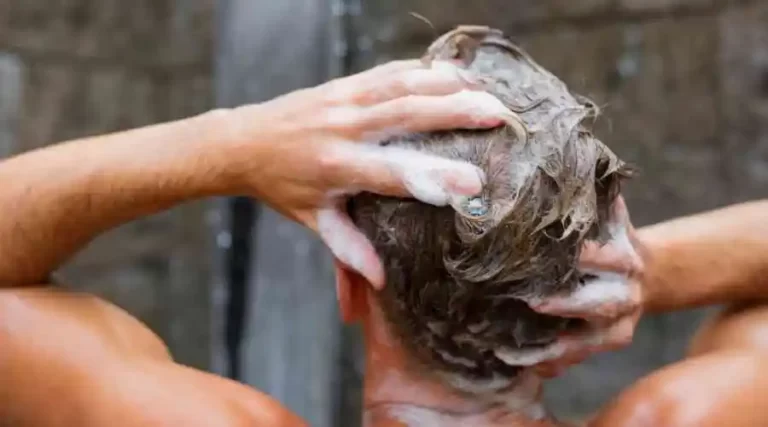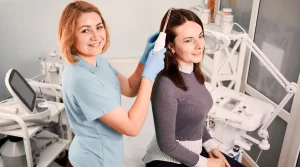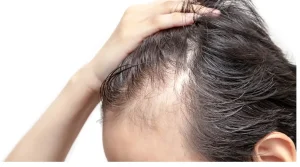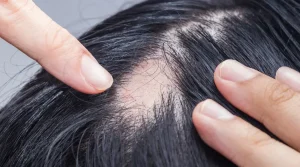The use of ketoconazole shampoos to combat hair thinning is on the rise. As if that weren’t bad enough, the manufacturers of these shampoos don’t market them as such. Is there any benefit to using ketoconazole shampoo, and should you start using one? Everything you need to know is right here in this comprehensive guide.
What Exactly Is Ketoconazole?
In 1976, Belgian pharmaceutical company Janssen Pharmaceutica discovered Ketoconazole. Imidazoles, of which it is a member, are an antifungal drug class. In the early 1980s, it was available for purchase.
Extina, Xolegel, and Ketoderm are a few of the many brand names it goes by today. Nizoral, on the other hand, is the most well-known trade name. This anti-dandruff drug is among the most popular on the market today.
Although this article focuses on the shampoo formulation, Ketoconazole is available in various forms. Gels, foams, creams, and even oral tablets are examples of these.
What's Involved in the Process
Because it is an antifungal, Ketoconazole also destroys yeast. Ergosterol, an organic compound present in fungi and yeast, is blocked by the medication. Both organisms’ cell membranes are affected by this. The creatures are unable to reproduce because their cell membranes have been damaged.
As a medication with a “wide spectrum of activity,” Ketoconazole, thus, a wide variety of microorganisms can be killed using it. In addition to the fungus that causes most dandruff (described below), the scalp can also be infected by several other, more serious fungal infections.
Thrush, psoriasis, and tinea capitis are among the illnesses that Ketoconazole can cure.
Ketoconazole is marketed as an over-the-counter medicated shampoo for treating dandruff and some fungal diseases, which must be made clear from the outset. Ketoconazole can treat fungal infections in almost any part of the body, depending on its type (topical or oral).
A fungus is not the cause of male pattern baldness. So neither the manufacturer nor the FDA has authorized Nizoral shampoo as a treatment for pattern hair loss.
Ketoconazole shampoos, on the other hand, have grown in popularity among those suffering from hair loss in recent years. Ketoconazole proponents frequently cite old studies that showed the drug to be effective. Ketoconazole shampoos were examined in these studies as a treatment for male pattern baldness, which was not their intended usage.
Ketoconazole Is intended usage should be examined first.
Dandruff, Seborrheic Dermatitis, & Ketoconazole
Dandruff, Seborrheic Dermatitis, & Ketoconazole
Every year, millions of individuals worldwide are affected with dandruff, the most common scalp problem. Itching and big, white flakes are the most common symptoms of this illness.
A person’s scalp and other body parts are constantly losing skin cells, but they are usually unseen. This is different in dandruff. The white, crusty flakes seen in dandruff are a cluster of dead skin cells that kept a high degree of cohesiveness and detached off the scalp.
In the modern world, scientists feel that this illness is complicated. In other words, it can be caused by various factors, including airborne pollutants and even stress. Malassezia, a fungus, is the most common culprit in most cases. Fungal species discovered in the scalps of healthy humans are part of this group. Malassezia, on the other hand, grows out of control in dandruff and essentially takes over the scalp.
Malassezia can cause dandruff, but the exact process behind this is not known. Regardless, there is compelling evidence linking Malassezia to dandruff development. Malassezia was detected in the scalps of 84% of dandruff patients in a 2014 research, for example. Malassezia was discovered in just 30% of otherwise healthy people.
Getting rid of Malassezia often helps alleviate dandruff symptoms. This is what Ketoconazole excels at.
Ketoconazole, a potent antifungal, prevents the yeast from reproducing or surviving. Scaling and other irritating sensations like itching and redness are reduced.
Seborrheic Dermatitis
Seborrheic dermatitis (SD) is a condition that is closely connected to dandruff.
Scaling, redness, and flaking (yellowish or white) are the most common signs of SD, similar to dandruff. In contrast to dandruff, it can appear anywhere on the body. Ears, eyelids, neck, upper back, chest, and armpits all fall within this category.
Scientists haven’t figured out this ailment, but they believe many factors control its intensity. Age, gender, and overall immune system health all play a role. Malassezia, like dandruff, has a job to play.
It should be no surprise that Ketoconazole is an effective therapy for syphilis when used as prescribed. The shampoo form can be used when the SD affects the scalp, but the cream version is utilized when the SD affects the face or other parts of the body.
When it comes to Ketoconazole and hair loss, is there any information available?
Many balding men take Ketoconazole as an anti-hair loss medicine even though it is neither licensed nor supplied.
Observations on Bald Men
Twenty-nine males with androgenetic alopecia took part in the trial, 27 of whom used Nizoral shampoo for over 21 months. Unmedicated shampoo was used by 12 of the guys.
Anagen hairs (hairs in the growth phase of their cycle) and the average hair shaft diameter had increased in the Nizoral group after 21 months of treatment.
After six months, the treatment resulted in thicker and fuller hair. After 15 months, the improvements had leveled off. On the other hand, males who used the unmedicated shampoo continued to decrease slowly but steadily, as is characteristic in AGA.
The second study was prompted by the findings of the first one (both of these studies were reported in the same paper).
In this second study, researchers looked at two distinct groups of men. Each group had four men. Nizoral shampoo was used by one group, whereas minoxidil was administered daily to the skin of the other group (while also using regular, unmedicated shampoo).
Hair density had increased in both the Ketoconazole and the minoxidil groups by 18% and 11%, respectively, after six months. Both groups saw a 7 percent increase in hair shaft diameter.
Anagen hairs’ density, size, and proportion increased unequivocally with the use of ketoconazole shampoo. Several more recent investigations have been conducted, the most recent of which was completed in 2002.
Although most of the study participants saw an increase in hair growth, each study had some drawbacks. Among these are the size of the sample and the consistency with which the samples are used.
Hair Loss on Women
Topical Ketoconazole was explored in 2019 by an Egyptian research team for the treatment of female pattern hair loss (female AGA). There were two groups of 40 women with thinning hair recruited by the researchers. The first group was given 2% minoxidil on the skin. As a result, minoxidil has been approved by the FDA to treat this problem. The second group was assigned a topical ketoconazole solution containing 2% ketoconazole. For six months, both groups of women applied the treatment daily.
Women in the minoxidil group experienced more rapid regrowth, but statistically, significant regrowth was seen in both groups by the 6-month mark. Additionally, the use of Ketoconazole resulted in fewer adverse reactions. Both groups of women were satisfied with their care. Ketoconazole may be a practical therapeutic choice for women with hair loss, according to this study.
Availability & Cost
Two concentrations of ketoconazole shampoo are available: 1% and 2%. One percent strength is accessible over the counter in many countries, but two percent is only available through prescription.
There are a wide variety of over-the-counter fungal treatments available. The most popular brand is Nizoral, and an 8-oz bottle costs approximately $15.
Despite the high price, you only need to use this product a few times a week at the beginning of treatment. Put it another way, you can count on the product to last a decent amount of time.
Possible Side Effects
A few adverse effects are possible with Ketoconazole, as with any drug. These side effects could make it difficult or impossible to continue taking the prescription.
Topical
Ketoconazole-containing shampoos are relatively safe, at least when used as directed for short periods.
According to Mayo Clinic, these are the most prevalent types of irritation: itching, stinging and burning. A shampoo containing Ketoconazole may induce hair loss in certain people.
If adverse effects do arise, they may go away as your body becomes used to the medicine. Discontinue treatment if these adverse effects are too severe and cause you distress.
Never forget to check in with your doctor before using any medication, no matter how safe it appears. This is a fact when it comes to prescription medications or chronic health concerns.
Oral
Although topical Ketoconazole is relatively safe, oral Ketoconazole is not.
The FDA issued a warning in 2013 and restricted the use of ketoconazole tablets, commonly prescribed for various skin conditions (18). The FDA has cited liver disease and adrenal gland dysfunction as possible causes of death. Another concern raised by the agency was the possibility of dangerous medication interactions.
The FDA recommended that the medicine no longer be used as a first-line treatment for fungal infections, so the drug’s label had to be changed. To be clear, these cautions only apply to the oral form of the medicine, not the shampoo version.
Enhancing Your Hair Care Routine With Ketoconazole
It is easy to incorporate ketoconazole products into your regular hair care routine because they are readily available shampoos.
A six to an eight-week regimen is recommended because this is a medication. That said, it is advisable for this shampoo every two to four days for the first two weeks and then once or twice a month after that (for maximum benefit).
How to Use Ketoconazole Shampoo
When utilizing Ketoconazole, it is crucial to ensure you get the most out of it. Taking a deeper look at the steps, we find the following:
- Pour a small amount of water onto the afflicted area of the scalp.
- Apply the ketoconazole shampoo immediately to the area where hair loss occurs and a wide area surrounding it.
- Allow the shampoo to lather for a full minute before rinsing.
- Let it be for at last 5 minutes before moving on.
- To clean, use lukewarm or cool water to flush.
It will be much more convenient if you begin your shower by applying Ketoconazole. When the Ketoconazole is working on your hair, you can wash the remainder of your body.
Pay special attention to the area of hair loss when using ketoconazole shampoo. As a result, you should concentrate most of your massage efforts on this area. For this reason, you should leave it on for a few minutes before rinsing.
Hot water damages the scalp and hair follicles, causing them to break down. It causes dryness, inflammation, and irritation, so it’s best to avoid it as much as possible. You can avoid inflammation by rinsing your scalp with lukewarm/cool water.
There are many other advantages of using cold water to clean, too! As a result, more oxygen and nutrients are delivered, and waste is removed.
Conclusion
Ketoconazole is, without a doubt, effective therapy for dandruff and scabies. However, the jury is still out on its hair-growth properties, though there are some robust data to support this hypothesis.
This component alone will not be able to reverse your hair loss and return a full head of hair. If it works for you, your hair loss should be stabilized. Even if you do have some hair growth, it will be minor.
Ketoconazole shampoo is generally not recommended for long-term or frequent use because it’s a medication. As a result, if you decide to include it in your hair loss program, try to use it as little as possible. You will likely need to use another shampoo in addition to Ketoconazole because of its harshness on the hair.





